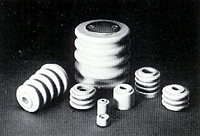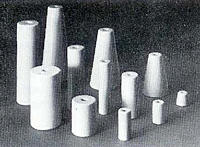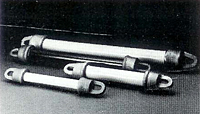Steatite Ceramic Products

View Our Different Steatite Ceramic Products
Properties of Steatite Ceramic
Compared to alumina and zirconia, steatite ceramic is relatively soft. However, its outstanding dielectric properties make it ideal for electrical insulation applications; its low thermal conductivity makes it excellent for various applications. LSP Industrial Ceramics (LSP) stocks steatite ceramic products in a wide range of sizes, diameters, and configurations to meet the unique requirements of commercial, industrial, and military applications. We maintain one of the industry’s largest in-stock inventories of ceramic products. We also offer custom alumina ceramic crucibles designed and manufactured to match your exact specifications. In addition to numerous standard sizes, LSP offers steatite ceramic products in many hard-to-find sizes and lengths. We can also produce custom steatite ceramics to match your exact specifications. Request a quote today on the steatite ceramic electrical insulator, bushing, or washer you need, or contact LSP for more information.
Steatite ceramic, also known as magnesium silicate, is a type of ceramic material that is composed mainly of magnesium oxide (MgO) and silicon dioxide (SiO2). It is a dense and non-porous ceramic that is often used for electrical and thermal insulation due to its high dielectric strength and low thermal expansion coefficient. Steatite ceramic has a white or gray color and is characterized by its high mechanical strength, excellent thermal shock resistance, and good chemical and corrosion resistance. It is widely used in a variety of industrial applications due to its superior properties and cost-effectiveness compared to other ceramics.
Steatite Ceramic Manufacturing Process:
Raw Materials Used in Production:
The raw materials used in the production of steatite ceramic typically include magnesium oxide (MgO) and silicon dioxide (SiO2), along with small amounts of other materials such as aluminum oxide (Al2O3) and iron oxide (Fe2O3). These raw materials are usually sourced from natural minerals, such as talc and kaolin.
Processing Steps Involved in Manufacturing:
The manufacturing process of steatite ceramic typically involves the following steps:
- Raw material preparation: The raw materials are first cleaned, sorted, and ground to a fine powder to ensure consistent particle size and chemical composition.
- Blending: The ground powders are then mixed together in a blender or ball mill to create a homogenous mixture.
- Forming: The mixture is then pressed into the desired shape using various techniques, such as dry pressing, isostatic pressing, or extrusion.
- Drying: The formed parts are dried in an oven or furnace to remove any remaining moisture.
- Firing: The dried parts are then fired in a kiln at high temperatures (usually between 2372 °F and 2732°F) to sinter the particles together and create a solid, dense ceramic material.
- Machining: The fired parts may then be machined to the desired shape and size using techniques such as drilling, grinding, and polishing.
Quality Control Measures:
Quality control measures are critical in ensuring that the final product meets the required specifications and standards. Overall, the manufacturing process of steatite ceramic requires careful attention to detail. Some of the quality control measures used in the manufacturing of steatite ceramic include:
- Raw material testing: The raw materials are tested for purity, particle size, and chemical composition to ensure that they meet the required specifications.
- In-process testing: Samples are taken at various stages of the manufacturing process to ensure that the parts are being produced according to the desired specifications.
- Final product testing: The final product is tested for properties such as density, strength, thermal conductivity, and electrical resistance to ensure that it meets the required standards.
- Quality control documentation: All data related to the manufacturing process, including test results and specifications, are documented to ensure traceability and quality control.
Advantages of Steatite Ceramic Products
The properties of steatite ceramic make it a highly desirable material for a wide range of applications, including electrical and electronic components, heating elements, cutting tools, and more. There are many advantages of Steatite Ceramic Products including:
- High Temperature Resistance: Steatite ceramic has a high melting point and can withstand high temperatures without losing its structural integrity, making it ideal for use in high-temperature applications.
- Excellent Electrical Insulation: Steatite ceramic has high dielectric strength and low dielectric loss, making it an excellent electrical insulator.
- High Mechanical Strength: Steatite ceramic is a hard and strong material, making it resistant to wear and tear and able to withstand high mechanical stress.
- Chemical Resistance: Steatite ceramic is resistant to many chemicals and can withstand exposure to acids, alkalis, and solvents.
- Biocompatibility: Steatite ceramic is non-toxic and biocompatible, making it suitable for use in medical and dental applications.
- Corrosion Resistance: Steatite ceramic is highly resistant to corrosion, making it suitable for use in harsh and corrosive environments.
- Cost-effective: Steatite ceramic is a cost-effective material compared to other advanced ceramics like alumina and zirconia, making it an ideal choice for applications where cost is a concern.
- Machinability: Steatite ceramic is relatively easy to machine and shape, making it suitable for use in complex and custom-designed components.
Types of Steatite Ceramic Products:
The main types of steatite ceramic products include:
Insulators: Steatite ceramic is an excellent electrical insulator, making it ideal for use in high-temperature electrical components such as insulators, terminal blocks, and spark plug insulators.
Heating Elements: Steatite ceramic has high thermal conductivity, which makes it an excellent choice for heating elements used in high-temperature applications such as industrial and laboratory furnaces.
Thermocouple Components: Steatite ceramic is also used in thermocouple components due to its high temperature resistance and ability to withstand thermal shock.
Grinding Media: Steatite ceramic is used as grinding media in ball mills and attritors for fine grinding of minerals and materials.
Thread Guides and Welding Pins: Steatite ceramic is also used as thread guides and welding pins in manufacturing processes due to its high mechanical strength and wear resistance.
Lamp Holders and Light Fixtures: Steatite ceramic is used in the lighting industry for its high electrical insulation properties, making it an ideal material for ceramic lamp holders and light fixtures.
Extrusion Dies and Cutting Tools: Steatite ceramic is used in the food processing and packaging industry for cutting tools and extrusion dies due to its high mechanical strength and wear resistance.
Overall, steatite ceramic has a wide range of applications and is used in many different industries due to its excellent properties, versatility, and cost-effectiveness.
Common Applications of Steatite Ceramic Products
The versatility and excellent properties of steatite ceramic make it an essential material for a wide range of applications across many different industries.
Some common applications of steatite ceramic products include:
- Electrical and Electronic Components: Steatite ceramic's high electrical insulation properties make it ideal for use in electrical and electronic components, including insulators, terminal blocks, switchgear, and surge protectors.
- Heating Elements: Steatite ceramic's high thermal conductivity and high-temperature resistance make it an excellent choice for heating elements in industrial and laboratory furnaces.
- Thermocouple Components: Steatite ceramic's high temperature resistance and ability to withstand thermal shock make it a popular choice for thermocouple components.
- Grinding Media: Steatite ceramic is used as grinding media in ball mills and attritors for fine grinding of minerals and materials.
- Thread Guides and Welding Pins: Steatite ceramic's high mechanical strength and wear resistance make it ideal for use as thread guides and welding pins in manufacturing processes.
- Lamp Holders and Light Fixtures: Steatite ceramic's high electrical insulation properties make it a popular choice for ceramic lamp holders and light fixtures.
- Extrusion Dies and Cutting Tools: Steatite ceramic's high mechanical strength and wear resistance make it suitable for use in cutting tools and extrusion dies in the food processing and packaging industry.
- Medical and Dental Implants: Steatite ceramic's biocompatibility and resistance to corrosion make it a suitable material for medical and dental implants.
How Steatite Ceramics Support Electrical and Thermal Applications
Steatite ceramic is a cost-effective, high-performance material used in electrical insulation, thermal management, and mechanical protection. LSP Industrial Ceramics manufactures steatite components for industries including electronics, lighting, manufacturing, and defense. Its low thermal conductivity and high dielectric strength make it ideal for high-voltage and high-temperature environments.
Custom Components for Specialized Requirements
LSP offers a wide range of steatite ceramic products including bushings, washers, insulators, beads, standoffs, and lead-ins. We also produce custom components to meet unique specifications in size, shape, and performance. Whether you need light-duty standoffs or heavy-duty suspension insulators, our team ensures precision and reliability across every order.
Manufacturing Expertise and Material Integrity
Steatite ceramic is composed primarily of magnesium oxide and silicon dioxide, giving it excellent thermal shock resistance, corrosion resistance, and machinability. LSP’s manufacturing process includes in-house forming, firing, and machining, backed by rigorous quality control. This ensures consistent performance and traceability for commercial, industrial, and military-grade applications.
Frequently Asked Questions (FAQ)
What Is Steatite Ceramic Made Of?
Steatite is primarily composed of magnesium oxide (MgO) and silicon dioxide (SiO₂), making it dense, non-porous, and highly resistant to heat and electricity.
What Are Common Applications for Steatite Ceramic?
Applications include electrical insulators, heating elements, thermocouple components, grinding media, thread guides, lamp holders, and extrusion dies.
How Does Steatite Compare to Alumina or Zirconia?
Steatite is softer but more cost-effective. It offers excellent dielectric properties and thermal stability, making it ideal for electrical and thermal insulation.
Can You Produce Custom Steatite Components?
Yes. We offer custom machining and forming services to meet specific design and performance requirements across industries.
Is Steatite Ceramic Suitable for Medical Use?
Yes. Its biocompatibility and corrosion resistance make it suitable for certain medical and dental applications.
Steatite Ceramic Products at LSP
LSP Industrial Ceramics (LSP) stocks steatite ceramic products in a wide range of sizes, diameters, and configurations to meet the unique requirements of commercial, industrial, and military applications. We maintain one of the industry’s largest in-stock inventories of ceramic products. We also offer custom alumina ceramic crucibles designed and manufactured to match your exact specifications. In addition to numerous standard sizes, LSP offers steatite ceramic products in many hard-to-find sizes and lengths. We can also produce custom steatite ceramics to match your exact specifications. Request a quote today on the steatite ceramic electrical insulator, bushing, or washer you need, or contact LSP for more information.











